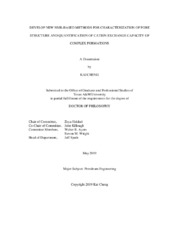| dc.description.abstract | Nuclear magnetic resonance (NMR) measurements have been applied successfully for characterizing porosity, pore-size distribution, and permeability of conventional formations. Interpreting NMR measurements in reservoirs with complex pore geometry can, however, be challenging. I introduced contrast agents for improved NMR measurements to enable the characterization of interconnected/isolated pores and reliable assessment of permeability in formations with complex pore structures. Moreover, the reliability of laboratory NMR measurements in clay-rich formations is influenced significantly by environmental effects such as relative humidity. I systematically investigated the mechanisms of clay hydration at different relative humidity levels and quantified the impacts of relative humidity on NMR-based core analysis, and I investigated the mechanisms of clay hydration at different humidity levels. Furthermore, assessment of cation exchange capacity (CEC) is important for interpreting electrical resistivity logs, but reliable quantification of CEC is usually challenging. I established an analytical correlation between CEC and volume of hydration water, which was quantified by NMR measurements, and I developed a new NMR-based method to quantify the CEC of pure clay minerals and rocks.
In this dissertation, I prepared superparamagnetic Fev3Ov4 nanoparticles and Mn^2^+ solution as contrast agents and injected them into different formation types to characterize the isolated pores and interconnected pores using NMR measurements. Then, I eliminated the influence of isolated porosity and improved the assessment of permeability for complex carbonate formations. The relative errors of permeability
(compared to directly-measured CEC) decreased from more than 80% to less than 10%. In addition, I combined NMR and thermogravimetric analysis (TGA) measurements to quantify the impact of relative humidity on core measurements. The variation in relative humidity caused more than 250% uncertainty in porosity assessment. The volume of hydration water was quantified at different relative humidity levels using NMR measurements. Based on the energy balance between electric potential energy and chemical potential energy, I established an analytical correlation between the volume of hydration water and the CEC of clay minerals and developed a new method for quantifying CEC. Then, I successfully quantified the CEC of four types of pure clay minerals with less than 7 meq/100 g error. Finally, I extended the new method for CEC quantification to rocks with multiple types of clay minerals. The relative error of CEC estimates (compared to the CEC from the wet chemistry method) for shaly sand formations was less than 4 meq/100 g. CEC estimates for organic-rich mudrock formations agreed with CEC estimates from the membrane potential method.
The contributions of this dissertation include (a) introducing contrast agents for improved NMR-based assessment of interconnected and isolated pores/fractures in complex formations, (b) improving NMR-based permeability assessment, (c) quantifying the impact of relative humidity on the reliability of NMR-based core measurements, and (d) establishing a new method for CEC assessment in pure clay minerals and in rocks with complex mineralogy by integrating NMR, X-ray diffraction (XRD), pyrolysis, and nitrogen adsorption-desorption measurements. | en |


